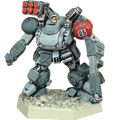Rattlesnake
The AV-2 Rattlesnake was the first Southern Gear to appear alongside the Jäger and the first of the successful “serpent” family developed by Territorial Arms. While the Jäger — for the most part — was a testament to the skill and power of SRID, the Rattlesnake was an announcement of the technical proficiency of the Antarctic in the new field of Gear design. Not lifted from Northern drawing boards, the Rattlesnake was (for its time) an effective and worthwhile companion to the Jäger.
The Rattlesnake was designed to be a general-purpose Gear that was particularly effective at hit-and-run or guerrilla warfare. It had become obvious to Southern commanders that most warfare with the North would consist of low-level engagements and campaigns of harassment, and they wanted a Gear that could give them an edge.
Territorial Arms introduced the use of armoplast ballistic plastic as the main armor material of their new design in a successful effort to reduce overall weight; this then allowed them to increase the Gear’s speed and maneuverability significantly beyond the capabilities of the first-generation of Jägers. Speed was paid for with the reduced effective armor, but the price was thought to be worth paying for a rapid strike Gear.
The Rattlesnake’s greatest innovation, however, was its fire-control computer, the TA Ciblix-250. The system improved combat accuracy (and hence efficiency) as compared to the Jäger’s, though the new system did have trouble handling multiple targets. The Ciblix-250 system involves the use of a large bank of holoscreens in the Gear cockpit, so the Gear’s head had to be larger than that of the Jäger. The turret-like assembly featured a sensor pod on a sliding rail as well as a large vision slit for a true view of the battlefield.
In general, the Rattlesnake’s weapon load was largely the same as the Jäger’s, notably in the use of a RS20 autocannon and HLB-12 grenade launcher. The Rattlesnake, however, featured a powerful shoulder-mounted FSRP-12 rocket pack. Although carrying only 9 rockets, the FSRP-12 gave the Gear improved hitting power, enabling it to rapidly take out armored targets.
Usage
The Rattlesnake served with distinction from the time of its release in TN 1731 all the way until the beginning of the next century. The speed and accuracy of the Gear made it a valuable addition to the battlefield and, despite its reduced armor, it was popular with pilots. The inclusion of reinforced armor plates around the cockpit for additional pilot safety was a strong point in its favor as far as soldiers were concerned.
In the TN 1750s the Gear gained a great deal of notoriety in the South with the so-called Barrington Campaign. This prolonged series of North-South skirmishes lasted from TN 1749 to TN 1754, sometimes flaring into an approximation of actual warfare, but usually simply claiming the lives of soldiers far from home. The Southern MILICIA Silicone Serpents regiment (now defunct) was the most celebrated of the units involved in the campaign and they used Rattlesnakes almost exclusively. Although newer Gears existed, the association with the regiment made the Rattlesnake the most glamorous war machine in the Southern Republic at the time. Several trideo movies would eventually be made about the Silicone Serpents and Rattlesnake merchandise has became a mainstay of many memorabilia collections.
The introduction of the Territorial Arms Copperhead and the Mandeers Heavy Industries Desert Viper would eventually drive the Rattlesnake into retirement. Although it performed very well for its time, the Gear was never updated with the care it should have been. Territorial Arms recommitted itself to the Jäger and true scout machines such as the ill-fated Anolis, while the Desert Viper’s firepower eventually proved more convincing than the Rattlesnake’s. By the time the Basilisk was introduced in TN 1838, the Rattlesnake was a second-line unit.
The Gear still has a legacy, however: the Territorial Arms/Dynamic Systems Sidewinder uses many concepts from the Rattlesnake, including the matching of speed and fire-power. The development of the Black Adder, based on the Sidewinder, also owes a debt to the old Gear. The Rattlesnake can still be found in active service in Badlands militias, rover gangs and a few civil defense forces in the South and served in several of the rag-tag units of the Peace River Army during the War of the Alliance.
Gallery
| Units | |||||||||||||||||||||||||||||||||||||||||||||||||||||||||||||
|---|---|---|---|---|---|---|---|---|---|---|---|---|---|---|---|---|---|---|---|---|---|---|---|---|---|---|---|---|---|---|---|---|---|---|---|---|---|---|---|---|---|---|---|---|---|---|---|---|---|---|---|---|---|---|---|---|---|---|---|---|---|
| Terra Nova |
| ||||||||||||||||||||||||||||||||||||||||||||||||||||||||||||
| Earth |
| ||||||||||||||||||||||||||||||||||||||||||||||||||||||||||||
| Caprice |
| ||||||||||||||||||||||||||||||||||||||||||||||||||||||||||||
| Utopia |
| ||||||||||||||||||||||||||||||||||||||||||||||||||||||||||||
| Eden |
| ||||||||||||||||||||||||||||||||||||||||||||||||||||||||||||

